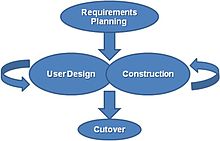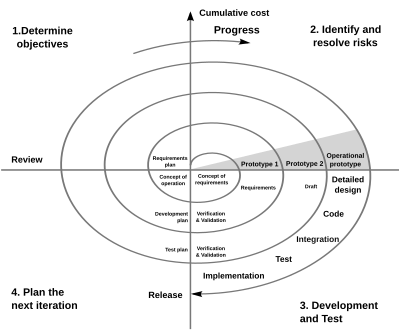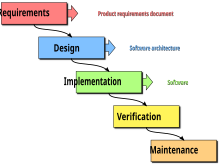Top-down and bottom-up are both strategies of information processing and knowledge ordering, used in a variety of fields including software, humanistic and scientific theories (see systemics), and management and organization. In practice, they can be seen as a style of thinking, teaching, or leadership.
A top-down approach (also known as stepwise design and stepwise refinement and in some cases used as a synonym of decomposition) is essentially the breaking down of a system to gain insight into its compositional sub-systems in a reverse engineering fashion. In a top-down approach an overview of the system is formulated, specifying, but not detailing, any first-level subsystems. Each subsystem is then refined in yet greater detail, sometimes in many additional subsystem levels, until the entire specification is reduced to base elements. A top-down model is often specified with the assistance of "black boxes", which makes it easier to manipulate. However, black boxes may fail to clarify elementary mechanisms or be detailed enough to realistically validate the model. Top down approach starts with the big picture. It breaks down from there into smaller segments.
A bottom-up approach is the piecing together of systems to give rise to more complex systems, thus making the original systems sub-systems of the emergent system. Bottom-up processing is a type of information processing based on incoming data from the environment to form a perception. From a cognitive psychology perspective, information enters the eyes in one direction (sensory input, or the "bottom"), and is then turned into an image by the brain that can be interpreted and recognized as a perception (output that is "built up" from processing to final cognition). In a bottom-up approach the individual base elements of the system are first specified in great detail. These elements are then linked together to form larger subsystems, which then in turn are linked, sometimes in many levels, until a complete top-level system is formed. This strategy often resembles a "seed" model, by which the beginnings are small but eventually grow in complexity and completeness. However, "organic strategies" may result in a tangle of elements and subsystems, developed in isolation and subject to local optimization as opposed to meeting a global purpose.
Product design and development
During the design and development of new products, designers and engineers rely on both a bottom-up and top-down approach. The bottom-up approach is being utilized when off-the-shelf or existing components are selected and integrated into the product. An example would include selecting a particular fastener, such as a bolt, and designing the receiving components such that the fastener will fit properly. In a top-down approach, a custom fastener would be designed such that it would fit properly in the receiving components. For perspective, for a product with more restrictive requirements (such as weight, geometry, safety, environment, etc.), such as a space-suit, a more top-down approach is taken and almost everything is custom designed.
Computer science
Software development
In the software development process, the top-down and bottom-up approaches play a key role.
Top-down approaches emphasize planning and a complete understanding of the system. It is inherent that no coding can begin until a sufficient level of detail has been reached in the design of at least some part of the system. Top-down approaches are implemented by attaching the stubs in place of the module. This, however, delays testing of the ultimate functional units of a system until significant design is complete.
Bottom-up emphasizes coding and early testing, which can begin as soon as the first module has been specified. This approach, however, runs the risk that modules may be coded without having a clear idea of how they link to other parts of the system, and that such linking may not be as easy as first thought. Re-usability of code is one of the main benefits of the bottom-up approach.
Top-down design was promoted in the 1970s by IBM researchers Harlan Mills and Niklaus Wirth. Mills developed structured programming concepts for practical use and tested them in a 1969 project to automate the New York Times morgue index. The engineering and management success of this project led to the spread of the top-down approach through IBM and the rest of the computer industry. Among other achievements, Niklaus Wirth, the developer of Pascal programming language, wrote the influential paper Program Development by Stepwise Refinement. Since Niklaus Wirth went on to develop languages such as Modula and Oberon (where one could define a module before knowing about the entire program specification), one can infer that top-down programming was not strictly what he promoted. Top-down methods were favored in software engineering until the late 1980s, and object-oriented programming assisted in demonstrating the idea that both aspects of top-down and bottom-up programming could be utilized.
Modern software design approaches usually combine both top-down and bottom-up approaches. Although an understanding of the complete system is usually considered necessary for good design, leading theoretically to a top-down approach, most software projects attempt to make use of existing code to some degree. Pre-existing modules give designs a bottom-up flavor. Some design approaches also use an approach where a partially functional system is designed and coded to completion, and this system is then expanded to fulfill all the requirements for the project.
Programming
Top-down is a programming style, the mainstay of traditional procedural languages, in which design begins by specifying complex pieces and then dividing them into successively smaller pieces. The technique for writing a program using top–down methods is to write a main procedure that names all the major functions it will need. Later, the programming team looks at the requirements of each of those functions and the process is repeated. These compartmentalized sub-routines eventually will perform actions so simple they can be easily and concisely coded. When all the various sub-routines have been coded the program is ready for testing. By defining how the application comes together at a high level, lower level work can be self-contained. By defining how the lower level abstractions are expected to integrate into higher level ones, interfaces become clearly defined.
In a bottom-up approach, the individual base elements of the system are first specified in great detail. These elements are then linked together to form larger subsystems, which then in turn are linked, sometimes in many levels, until a complete top-level system is formed. This strategy often resembles a "seed" model, by which the beginnings are small, but eventually grow in complexity and completeness. Object-oriented programming (OOP) is a paradigm that uses "objects" to design applications and computer programs. In mechanical engineering with software programs such as Pro/ENGINEER, Solidworks, and Autodesk Inventor users can design products as pieces not part of the whole and later add those pieces together to form assemblies like building with Lego. Engineers call this piece part design.
In a bottom-up approach, good intuition is necessary to decide the functionality that is to be provided by the module. If a system is to be built from an existing system, this approach is more suitable as it starts from some existing modules.
Parsing
Parsing is the process of analyzing an input sequence (such as that read from a file or a keyboard) in order to determine its grammatical structure. This method is used in the analysis of both natural languages and computer languages, as in a compiler.
Bottom-up parsing is a strategy for analyzing unknown data relationships that attempts to identify the most fundamental units first, and then to infer higher-order structures from them. Top-down parsers, on the other hand, hypothesize general parse tree structures and then consider whether the known fundamental structures are compatible with the hypothesis. See Top-down parsing and Bottom-up parsing.
Nanotechnology
Top-down and bottom-up are two approaches for the manufacture of products. These terms were first applied to the field of nanotechnology by the Foresight Institute in 1989 in order to distinguish between molecular manufacturing (to mass-produce large atomically precise objects) and conventional manufacturing (which can mass-produce large objects that are not atomically precise). Bottom-up approaches seek to have smaller (usually molecular) components built up into more complex assemblies, while top-down approaches seek to create nanoscale devices by using larger, externally controlled ones to direct their assembly. Certain valuable nanostructures, such as Silicon nanowires, can be fabricated using either approach, with processing methods selected on the basis of targeted applications.
The top-down approach often uses the traditional workshop or microfabrication methods where externally controlled tools are used to cut, mill, and shape materials into the desired shape and order. Micropatterning techniques, such as photolithography and inkjet printing belong to this category. Vapor treatment can be regarded as a new top-down secondary approaches to engineer nanostructures.
Bottom-up approaches, in contrast, use the chemical properties of single molecules to cause single-molecule components to (a) self-organize or self-assemble into some useful conformation, or (b) rely on positional assembly. These approaches utilize the concepts of molecular self-assembly and/or molecular recognition. See also Supramolecular chemistry. Such bottom-up approaches should, broadly speaking, be able to produce devices in parallel and much cheaper than top-down methods, but could potentially be overwhelmed as the size and complexity of the desired assembly increases.
Neuroscience and psychology
These terms are also employed in neuroscience, cognitive neuroscience and cognitive psychology to discuss the flow of information in processing. Typically sensory input is considered "bottom-up", and higher cognitive processes, which have more information from other sources, are considered "top-down". A bottom-up process is characterized by an absence of higher level direction in sensory processing, whereas a top-down process is characterized by a high level of direction of sensory processing by more cognition, such as goals or targets (Beiderman, 19).
According to college teaching notes written by Charles Ramskov, Rock, Neiser, and Gregory claim that top-down approach involves perception that is an active and constructive process. Additionally, it is an approach not directly given by stimulus input, but is the result of stimulus, internal hypotheses, and expectation interactions. According to Theoretical Synthesis, "when a stimulus is presented short and clarity is uncertain that gives a vague stimulus, perception becomes a top-down approach."
Conversely, psychology defines bottom-up processing as an approach wherein there is a progression from the individual elements to the whole. According to Ramskov, one proponent of bottom-up approach, Gibson, claims that it is a process that includes visual perception that needs information available from proximal stimulus produced by the distal stimulus. Theoretical Synthesis also claims that bottom-up processing occurs "when a stimulus is presented long and clearly enough."
Cognitively speaking, certain cognitive processes, such as fast reactions or quick visual identification, are considered bottom-up processes because they rely primarily on sensory information, whereas processes such as motor control and directed attention are considered top-down because they are goal directed. Neurologically speaking, some areas of the brain, such as area V1 mostly have bottom-up connections. Other areas, such as the fusiform gyrus have inputs from higher brain areas and are considered to have top-down influence.
The study of visual attention provides an example. If your attention is drawn to a flower in a field, it may be because the color or shape of the flower are visually salient. The information that caused you to attend to the flower came to you in a bottom-up fashion—your attention was not contingent upon knowledge of the flower; the outside stimulus was sufficient on its own. Contrast this situation with one in which you are looking for a flower. You have a representation of what you are looking for. When you see the object you are looking for, it is salient. This is an example of the use of top-down information.
In cognitive terms, two thinking approaches are distinguished. "Top-down" (or "big chunk") is stereotypically the visionary, or the person who sees the larger picture and overview. Such people focus on the big picture and from that derive the details to support it. "Bottom-up" (or "small chunk") cognition is akin to focusing on the detail primarily, rather than the landscape. The expression "seeing the wood for the trees" references the two styles of cognition.
Management and organization
In the fields of management and organization, the terms "top-down" and "bottom-up" are used to describe how decisions are made and/or how change is implemented.
A "top-down" approach is where an executive decision maker or other top person makes the decisions of how something should be done. This approach is disseminated under their authority to lower levels in the hierarchy, who are, to a greater or lesser extent, bound by them. For example, when wanting to make an improvement in a hospital, a hospital administrator might decide that a major change (such as implementing a new program) is needed, and then the leader uses a planned approach to drive the changes down to the frontline staff (Stewart, Manges, Ward, 2015).
A "bottom-up" approach to changes is one that works from the grassroots—from a large number of people working together, causing a decision to arise from their joint involvement. A decision by a number of activists, students, or victims of some incident to take action is a "bottom-up" decision. A bottom-up approach can be thought of as "an incremental change approach that represents an emergent process cultivated and upheld primarily by frontline workers" (Stewart, Manges, Ward, 2015, p. 241).
Positive aspects of top-down approaches include their efficiency and superb overview of higher levels. Also, external effects can be internalized. On the negative side, if reforms are perceived to be imposed 'from above', it can be difficult for lower levels to accept them (e.g. Bresser-Pereira, Maravall, and Przeworski 1993). Evidence suggests this to be true regardless of the content of reforms (e.g. Dubois 2002). A bottom-up approach allows for more experimentation and a better feeling for what is needed at the bottom. Other evidence suggests that there is a third combination approach to change (see Stewart, Manges, Ward, 2015).
Public health
Both top-down and bottom-up approaches exist in public health. There are many examples of top-down programs, often run by governments or large inter-governmental organizations (IGOs); many of these are disease-specific or issue-specific, such as HIV control or Smallpox Eradication. Examples of bottom-up programs include many small NGOs set up to improve local access to healthcare. However, a lot of programs seek to combine both approaches; for instance, guinea worm eradication, a single-disease international program currently run by the Carter Center has involved the training of many local volunteers, boosting bottom-up capacity, as have international programs for hygiene, sanitation, and access to primary health-care.
Architecture
Often, the École des Beaux-Arts school of design is said to have primarily promoted top-down design because it taught that an architectural design should begin with a parti, a basic plan drawing of the overall project.
By contrast, the Bauhaus focused on bottom-up design. This method manifested itself in the study of translating small-scale organizational systems to a larger, more architectural scale (as with the woodpanel carving and furniture design).
Ecology
In ecology, top-down control refers to when a top predator controls the structure or population dynamics of the ecosystem. The interactions between these top predators and their prey is what influences lower trophic levels. Changes in the top level of trophic levels have an inverse effect on the lower trophic levels. Top-down control can have negative effects on the surrounding ecosystem if there is a drastic change in the number of predators. The classic example is of kelp forest ecosystems. In such ecosystems, sea otters are a keystone predator. They prey on urchins which in turn eat kelp. When otters are removed, urchin populations grow and reduce the kelp forest creating urchin barrens. This reduces the diversity of the ecosystem as a whole and can detrimental effects on all of the other organisms. In other words, such ecosystems are not controlled by productivity of the kelp, but rather, a top predator.
One can see the inverse effect that top-down control has in this example; when the population of otters decreased, the population of the urchins increased.
Bottom-up control in ecosystems refers to ecosystems in which the nutrient supply, productivity, and type of primary producers
(plants and phytoplankton) control the ecosystem structure. If there
are not enough resources or producers in the ecosystem, there is not
enough energy left for the rest of the animals in the food chain because
of biomagnification and the ecological efficiency.
An example would be how plankton populations are controlled by the
availability of nutrients. Plankton populations tend to be higher and
more complex in areas where upwelling brings nutrients to the surface.
There are many different examples of these concepts. It is common for
populations to be influenced by both types of control, and there is
still debates going on as to which type of control affects food webs in
certain ecosystems.
Philosophy and ethics
Top-down reasoning in ethics is when the reasoner starts from abstract universalisable principles and then reasons down them to particular situations. Bottom-up reasoning occurs when the reasoner starts from intuitive particular situational judgements and then reasons up to principles. Reflective Equilibrium occurs when there is interaction between top-down and bottom-up reasoning until both are in harmony. That is to say, when universalisable abstract principles are reflectively found to be in equilibrium with particular intuitive judgements. The process occurs when cognitive dissonance occurs when reasoners try to resolve top-down with bottom-up reasoning, and adjust one or the other, until they are satisfied they have found the best combinations of principles and situational judgements.










